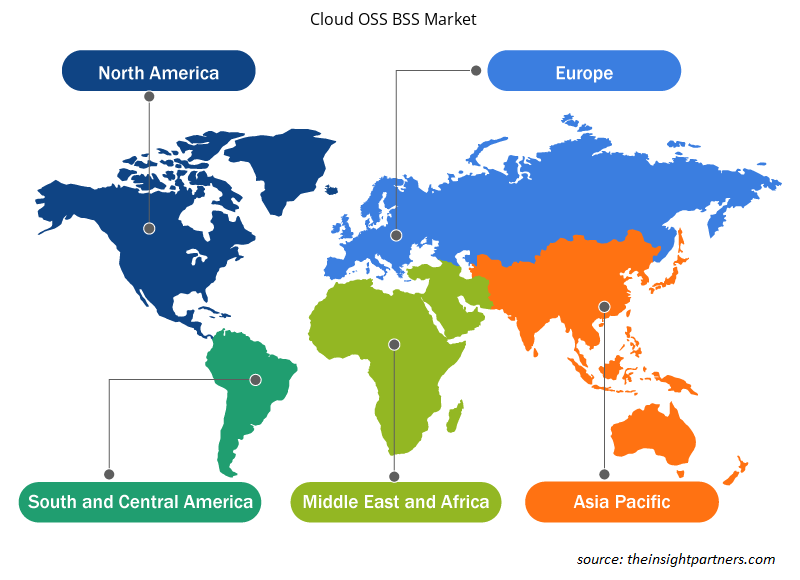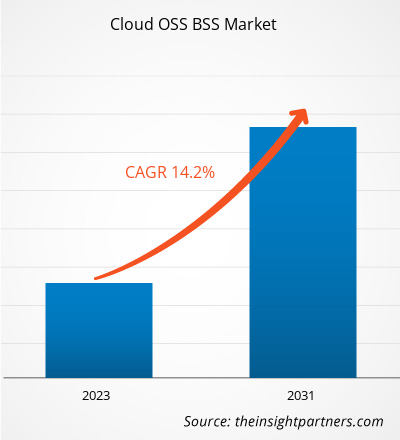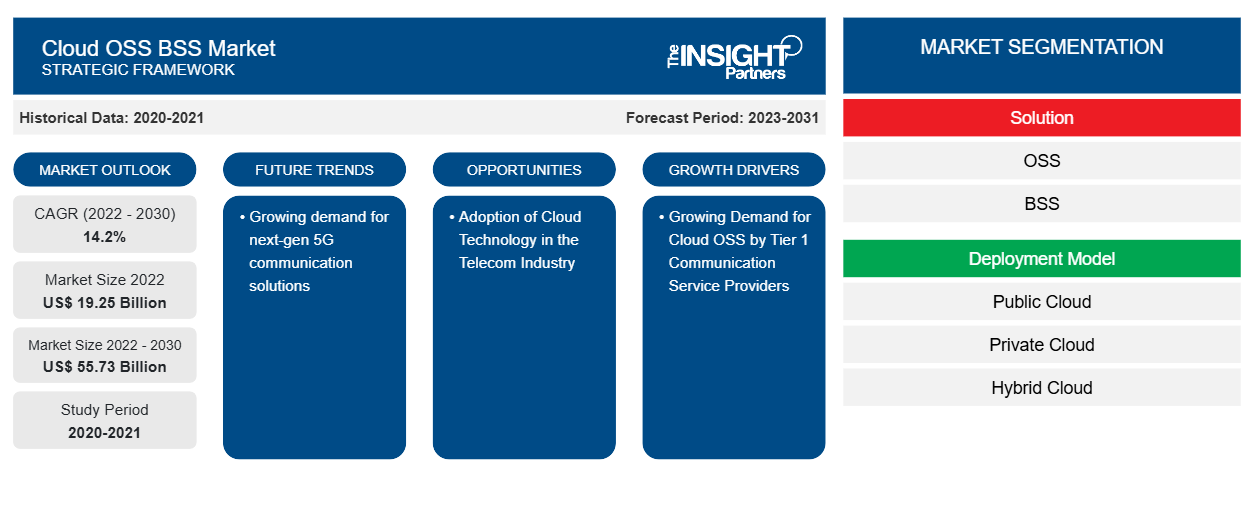Se prevé que el tamaño del mercado de OSS BSS en la nube alcance los 55.730 millones de dólares en 2030, frente a los 19.250 millones de dólares en 2022. Se espera que el mercado registre una CAGR del 14,2 % durante el período 2022-2030. Es probable que la creciente demanda de soluciones de comunicación 5G de próxima generación siga siendo una tendencia clave en el mercado.
Análisis del mercado de OSS BSS en la nube
Las empresas de sistemas de soporte operativo (OSS) y sistemas de soporte empresarial (BSS) en la nube están invirtiendo significativamente en el desarrollo de soluciones nuevas e innovadoras en respuesta a la creciente demanda de estos productos. Los proveedores están añadiendo diferentes funcionalidades a sus soluciones para diferenciarse de sus competidores. En julio de 2021, Sterlite Technologies Ltd (STL) anunció su plan de asociarse con Microsoft para proporcionar soluciones OSS/BSS nativas de la nube a los proveedores de servicios de telecomunicaciones. Estas soluciones ayudarían a las empresas de telecomunicaciones a crear aplicaciones preparadas para el futuro a través de su plataforma BSS digital. En virtud de esta asociación, STL proporcionará a las empresas de telecomunicaciones acceso a microservicios modulares flexibles, un ecosistema de desarrollo de aplicaciones integral y nativo de la nube y un sistema de gestión de nube híbrido. Estas innovaciones en las soluciones OSS BSS en la nube, respaldadas por las elevadas inversiones de los proveedores para mejorar sus carteras de productos y satisfacer los cambiantes requisitos de los clientes, están impulsando el crecimiento del mercado de OSS BSS en la nube.
Descripción general del mercado de OSS BSS en la nube
Los sistemas de soporte de operaciones y los sistemas de soporte empresarial utilizan computación en la nube, herramientas de automatización y análisis para optimizar las operaciones en toda la organización de telecomunicaciones , incluidas las operaciones y las actividades de los clientes. Al utilizar OSS y BSS en conjunto, las empresas de telecomunicaciones pueden conectar fácilmente a los clientes con soluciones tecnológicas confiables.
Personalice este informe según sus necesidades
Obtendrá personalización en cualquier informe, sin cargo, incluidas partes de este informe o análisis a nivel de país, paquete de datos de Excel, así como también grandes ofertas y descuentos para empresas emergentes y universidades.
-
Obtenga las principales tendencias clave del mercado de este informe.Esta muestra GRATUITA incluirá análisis de datos, desde tendencias del mercado hasta estimaciones y pronósticos.
Factores impulsores y oportunidades del mercado de OSS BSS en la nube
Demanda creciente de OSS en la nube por parte de proveedores de servicios de comunicación de primer nivel
Las soluciones OSS en la nube ayudan a la industria de las comunicaciones a abordar muchos desafíos comerciales y técnicos. El OSS en la nube se utiliza para múltiples aplicaciones debido a su heterogeneidad tecnológica y panorama de proveedores. Estas soluciones ofrecen una manera eficiente y sencilla de compartir recursos, automatizar y monitorear. Al utilizar soluciones OSS en la nube, los CSP simplifican los procedimientos de actualización de software, lo que reduce considerablemente el costo al garantizar un tiempo de inactividad casi nulo durante la actualización. El OSS en la nube beneficia a los CSP de nivel 1 al brindar elasticidad para manejar escenarios de tráfico en ráfagas sin ninguna inversión inicial. La solución OSS en la nube también proporciona un tiempo de comercialización más rápido para nuevos servicios, ya que las nuevas capacidades se pueden ampliar o reducir fácilmente según la demanda. Además, las soluciones OSS en la nube brindan a los CSP de nivel 1 soluciones de big data y análisis. Por lo tanto, el aumento resultante en la demanda de soluciones OSS en la nube entre estos proveedores de servicios impulsa el mercado BSS OSS en la nube.
Adopción de tecnología en la nube en la industria de las telecomunicaciones
La tecnología de la nube está teniendo un impacto significativo en la industria de las telecomunicaciones, ya que reduce los costos operativos y administrativos para las empresas de telecomunicaciones. También mejora su comunicación y colaboración con las redes de distribución de contenido. Además, los proveedores de servicios en la nube ayudan a las empresas de telecomunicaciones a centrarse en los servicios comerciales esenciales en lugar de en las TI, las actualizaciones de servidores y los problemas de mantenimiento. La tecnología de la nube ha aumentado el número de proveedores de telecomunicaciones en todo el mundo. Las plataformas del modelo de distribución en la nube brindan servicios de TI y comunicación a través de cualquier red , como fija y móvil, con cobertura mundial. También se puede utilizar cualquier dispositivo conectado de los usuarios finales, como teléfonos inteligentes, PC y televisores. Por lo tanto, la creciente adopción de la tecnología de la nube en la industria de las telecomunicaciones está creando más oportunidades para el mercado.
Análisis de segmentación del informe de mercado de OSS BSS en la nube
Los segmentos clave que contribuyeron a la derivación del análisis del mercado de OSS BSS en la nube son la solución, el modelo de implementación y el tamaño de la empresa.
- Según la solución, el mercado de OSS BSS en la nube se divide en OSS (gestión y orquestación de redes, gestión de recursos, análisis y aseguramiento, y diseño y cumplimiento de servicios) y BSS (facturación y gestión de ingresos, gestión de productos, gestión de clientes y otros). El segmento OSS tuvo una mayor participación de mercado en 2022.
- Por tamaño de empresa, el mercado está segmentado en pequeñas y medianas empresas y grandes empresas) e industria (TI y telecomunicaciones, BFSI, medios y entretenimiento, atención médica y otros).
Análisis de la cuota de mercado de OSS BSS en la nube por geografía
El alcance geográfico del informe de mercado de OSS BSS en la nube se divide principalmente en cinco regiones: América del Norte, Asia Pacífico, Europa, Medio Oriente y África, y América del Sur y Central.
América del Norte domina el mercado de OSS BSS en la nube. Estados Unidos posee más de la mitad de la cuota de ingresos regional, ya que tiene el mercado de telecomunicaciones más maduro. Por otro lado, la creciente competencia entre los proveedores de servicios de comunicaciones para aumentar la base de clientes y mejorar la eficiencia operativa brindaría oportunidades de crecimiento para el mercado de OSS BSS en la nube en Canadá.
Perspectivas regionales del mercado de OSS BSS en la nube
Los analistas de Insight Partners explicaron en detalle las tendencias y los factores regionales que influyen en el mercado de OSS BSS en la nube durante el período de pronóstico. Esta sección también analiza los segmentos y la geografía del mercado de OSS BSS en la nube en América del Norte, Europa, Asia Pacífico, Oriente Medio y África, y América del Sur y Central.

- Obtenga datos regionales específicos para el mercado de OSS BSS en la nube
Alcance del informe de mercado de OSS BSS en la nube
| Atributo del informe | Detalles |
|---|---|
| Tamaño del mercado en 2022 | US$ 19,25 mil millones |
| Tamaño del mercado en 2030 | US$ 55,73 mil millones |
| CAGR global (2022-2030) | 14,2% |
| Datos históricos | 2020-2021 |
| Período de pronóstico | 2023-2031 |
| Segmentos cubiertos |
Por solución
|
| Regiones y países cubiertos |
América del norte
|
| Líderes del mercado y perfiles de empresas clave |
|
Densidad de actores del mercado: comprensión de su impacto en la dinámica empresarial
El mercado de OSS BSS en la nube está creciendo rápidamente, impulsado por la creciente demanda de los usuarios finales debido a factores como la evolución de las preferencias de los consumidores, los avances tecnológicos y una mayor conciencia de los beneficios del producto. A medida que aumenta la demanda, las empresas amplían sus ofertas, innovan para satisfacer las necesidades de los consumidores y aprovechan las tendencias emergentes, lo que impulsa aún más el crecimiento del mercado.
La densidad de actores del mercado se refiere a la distribución de las empresas o firmas que operan dentro de un mercado o industria en particular. Indica cuántos competidores (actores del mercado) están presentes en un espacio de mercado determinado en relación con su tamaño o valor total de mercado.
Las principales empresas que operan en el mercado de OSS BSS en la nube son:
- Amdocs Ltd
- Corporación Oracle
- Telefonaktiebolaget LM Ericsson
- Desarrollo empresarial de Hewlett Packard LP
- Huawei Technologies Co. Ltd.
- Soluciones Axino GmbH
Descargo de responsabilidad : Las empresas enumeradas anteriormente no están clasificadas en ningún orden particular.

- Obtenga una descripción general de los principales actores clave del mercado de OSS BSS en la nube
Noticias y desarrollos recientes del mercado de OSS BSS en la nube
El mercado de OSS BSS en la nube se evalúa mediante la recopilación de datos cualitativos y cuantitativos posteriores a la investigación primaria y secundaria, que incluye publicaciones corporativas importantes, datos de asociaciones y bases de datos. A continuación, se enumeran algunos de los desarrollos en el mercado de OSS BSS en la nube:
- Vodafone ha anunciado una nueva alianza estratégica con Oracle. La alianza se enmarca en los esfuerzos continuos de Vodafone por convertirse en una empresa tecnológica de pleno derecho, que prevé una revisión y modernización extrema de sus sistemas de TI. La idea es proporcionar una "plataforma en la nube dedicada" para que Vodafone modernice "miles de bases de datos Oracle", así como para respaldar y escalar sus sistemas OSS y BSS "de misión crítica", incluidos CRM y gestión de pedidos. De este modo, Vodafone puede crear nuevas aplicaciones basadas en la nube con mayor rapidez y establecerlas en varios mercados simultáneamente. (Fuente: Vodafone, comunicado de prensa, marzo de 2022).
- Según un comunicado de prensa de Hewlett Packard Enterprise, Emirates Integrated Telecommunications Company (EITCdu) está introduciendo el software de orquestación de servicios de extremo a extremo de HPE para acelerar su transformación digital y crear nuevas fuentes de ingresos a partir de su red 5G en expansión. du está migrando de un sistema heredado a un sistema de soporte de operaciones (OSS) de última generación para respaldar nuevos servicios y mejorar la experiencia de sus clientes. Esta transformación digital, impulsada por HPE, permitirá a du ampliar su oferta, mejorar el tiempo de comercialización y monetizar su inversión en 5G. (Fuente: Emirates Integrated Telecommunications Company, comunicado de prensa, febrero de 2022)
Informe de mercado de OSS BSS en la nube: cobertura y resultados
El informe “Tamaño y pronóstico del mercado de OSS BSS en la nube (2020-2030)” proporciona un análisis detallado del mercado que cubre las siguientes áreas:
- Tamaño y pronóstico del mercado de OSS BSS en la nube a nivel global, regional y nacional para todos los segmentos clave del mercado cubiertos bajo el alcance
- Tendencias del mercado de OSS BSS en la nube, así como dinámicas del mercado, como impulsores, restricciones y oportunidades clave
- Análisis detallado de las cinco fuerzas de Porter y PEST y FODA
- Análisis del mercado de OSS BSS en la nube que abarca las tendencias clave del mercado, el marco global y regional, los principales actores, las regulaciones y los desarrollos recientes del mercado
- Análisis del panorama de la industria y de la competencia que abarca la concentración del mercado, el análisis de mapas de calor, los actores destacados y los desarrollos recientes del mercado de OSS BSS en la nube
- Perfiles detallados de empresas
- Análisis histórico (2 años), año base, pronóstico (7 años) con CAGR
- Análisis PEST y FODA
- Tamaño del mercado, valor/volumen: global, regional y nacional
- Industria y panorama competitivo
- Conjunto de datos de Excel
Informes recientes
Testimonios
Razón para comprar
- Toma de decisiones informada
- Comprensión de la dinámica del mercado
- Análisis competitivo
- Información sobre clientes
- Pronósticos del mercado
- Mitigación de riesgos
- Planificación estratégica
- Justificación de la inversión
- Identificación de mercados emergentes
- Mejora de las estrategias de marketing
- Impulso de la eficiencia operativa
- Alineación con las tendencias regulatorias























 Obtenga una muestra gratuita para - Mercado de OSS BSS en la nube
Obtenga una muestra gratuita para - Mercado de OSS BSS en la nube